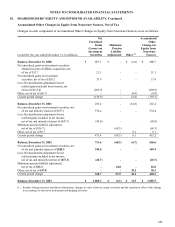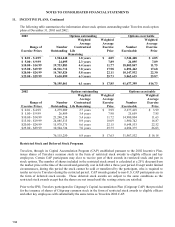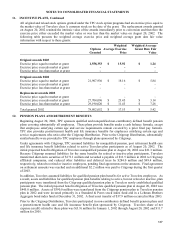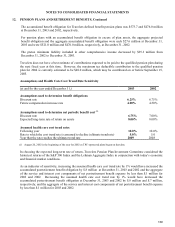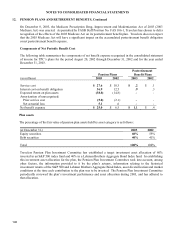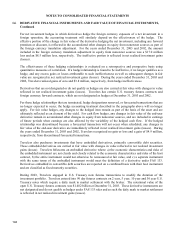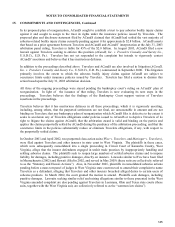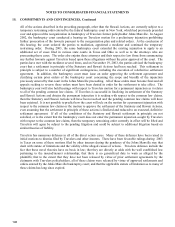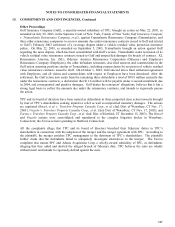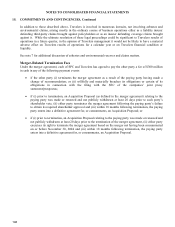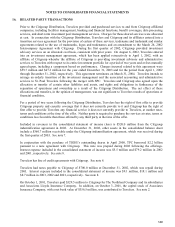Travelers 2003 Annual Report Download - page 143
Download and view the complete annual report
Please find page 143 of the 2003 Travelers annual report below. You can navigate through the pages in the report by either clicking on the pages listed below, or by using the keyword search tool below to find specific information within the annual report.141
NOTES TO CONSOLIDATED FINANCIAL STATEMENTS
13. LEASES
Prior to the Citigroup Distribution, most leasing functions for TPC and its subsidiaries were administered by
Travelers. Rent expense related to these leases was shared by a former affiliate and Travelers on a cost
allocation method based generally on estimated usage by department. In conjunction with the Citigroup
Distribution, Travelers purchased certain properties from Citigroup. Rent expense was $115.3 million,
$123.3 million and $121.0 million in 2003, 2002 and 2001, respectively.
Future minimum annual rental payments under noncancellable operating leases are $81.6 million, $68.3 million,
$52.9 million, $39.3 million, $21.9 million and $37.6 million for 2004, 2005, 2006, 2007, 2008 and 2009 and
thereafter, respectively. Future sublease rental income of approximately $1.9 million will partially offset these
commitments.
14. DERIVATIVE FINANCIAL INSTRUMENTS AND FAIR VALUE OF FINANCIAL INSTRUMENTS
Derivative Financial Instruments
Travelers uses derivative financial instruments, including interest rate swaps, equity swaps, credit derivatives,
options, financial futures and forward contracts, as a means of hedging exposure to interest rate, equity price
change and foreign currency risk. Travelers insurance subsidiaries do not hold or issue derivatives for trading
purposes.
To qualify as a hedge, the hedge relationship is designated and formally documented at inception detailing the
particular risk management objective and strategy for the hedge, which includes the item and risk that is being
hedged, the derivative that is being used, as well as how effectiveness is being assessed. A derivative has to be
highly effective in accomplishing the objective of offsetting either changes in fair value or cash flows for the risk
being hedged.
For fair value hedges, changes in the fair value of derivatives are reflected in net realized investment gains
(losses), together with changes in the fair value of the related hedged item. Travelers did not utilize fair value
hedges during the years ended December 31, 2003 and 2002.
For cash flow hedges, the accounting treatment depends on the effectiveness of the hedge. To the extent these
derivatives are effective in offsetting the variability of the hedged cash flows, changes in the derivatives’ fair
value will not be included in current earnings but are reported in accumulated other changes in equity from
nonowner sources. These changes in fair value will be included in the earnings of future periods when earnings
are also affected by the variability of the hedged cash flows. At December 31, 2003, the amount that Travelers
expects to include in net realized investment gains (losses) over the next twelve months for these cash flow
hedges is not significant. To the extent these derivatives are not effective, changes in their fair value are
immediately included in net realized investment gains (losses). Travelers cash flow hedges primarily include
hedges of floating rate available-for-sale securities and certain forecasted transactions up to a maximum tenure
of one year. While the earnings impact of cash flow hedges is similar to the previous accounting practice, the
amounts included in the accumulated other changes in equity from nonowner sources will vary depending on
market conditions.


